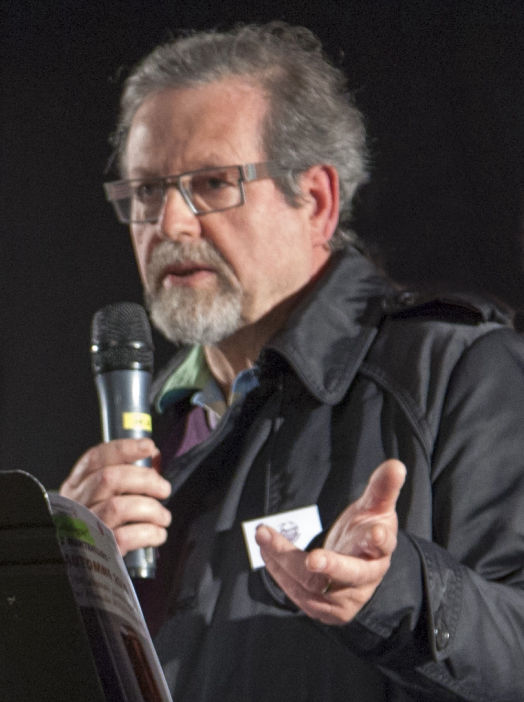Vers une abstraction des transparences :
C’est en observant la projection des couleurs des vitraux qui forment des images abstraites éphémères que s’est développé son intérêt pour la couleur lumineuse pure.
En 1980, il définit une théorie sur les 4 couleurs primordiales de la lumière et commence à développer un travail pictural abstrait.
La lumière et ses champs chromatiques ne sont qu’énergies vibratoires. Ils ont besoin de traverser des éléments transparents comme l’air et l’eau pour se révéler à nous.
L’aspect transparent des couleurs et son rendu pictural sont un des aspects importants de son travail.
Apporter la transparence à la couleur, c’est la rendre plus lumineuse et la rapprocher de son état originel la lumière blanche.
La transparence de la couleur par superposition permet la transmutation de la couleur matière en couleur lumière.
Son répertoire de formes s’inspire des constructions primitives souvent géométriques que l’on trouve dans la nature.
Vibrations des couleurs et synchronicité :
Les vibrations des couleurs transparentes associées à une grande variété de formes géométriques déclenchent sur celui qui regarde des émotions et des énergies positives.
Dans son processus créatif, il lui arrive de provoquer le hasard pour obtenir d’ ”heureuses coïncidences” (Carl Gustav JUNG appelle cela la synchronicité qui se retrouve dans des domaines variés comme la physique quantique et la biologie).
Le monde est en perpétuel changement ce qui l’incite à continuer ses recherches plastiques vers de nouvelles voies et de nouveaux supports.
Son travail est avant tout pictural. Il est cependant également édité sur différents supports pour en permettre l’accès au plus grand nombre : estampes numériques sur papier, Subligraphie© sur aluminium et animations vidéos numériques.
Ses œuvres hautes en couleurs s’adaptent aux très grands formats comme l’habillage architectural urbain. Il réalise en 2018 pour le Bureau d’Information Touristique de Giverny une œuvre murale : ”Le souffle d’Iris”.
Towards an abstraction of transparencies:
It is by observing the projection of stained glass colours that form ephemeral abstract images that his interest in pure luminous color developed.
In 1980, he defined a theory on the four primordial colors of light and began to develop an abstract pictorial work.
Light and its chromatic fields are merely vibratory energies. They need to cross transparent elements like air and water to reveal themselves to us.
The transparent aspect of the colors and its pictorial rendering are one of the important aspects of his work.
To bring transparency to color is to make it brighter and bring it closer to its original state of white light.
The transparency of the color by superposition allows transmutation of the material colour into light color.
His repertoire of forms is inspired by the often geometric primitive constructions found in nature.
Color vibration and synchronicity:
The vibrations of transparent colors associated with a great variety of geometrical forms trigger in the observer positive emotions and energies.
In his creative process, he sometimes provokes chance to obtain "happy coincidences" (Carl Gustav JUNG calls this synchronicity that is found in various fields such as quantum physics and biology).
The world is constantly changing, which encourages him to continue his plastic research into new paths and new media.
His artwork is first of all pictorial. However, it is also published on different media to allow access to as many people as possible: digital prints on paper, Subligraphie © on aluminum and digital video animations.
His colorful artworks adapt to very large formats such as urban architectural cladding. In 2018, he created a mural for the Tourist Information Office of Giverny: "The breath of Iris".
Zu einer Transparenzenabstraktion :
Debullys Interesse an pure, leuchtende Farbe entwickelte sich, als er die Projektion der bunten Kirchenfenstern beobachtete.
1980 definiert er eine Theorie über die 4 grundlegenden Farben des Lichtes und fängt an, ein abstraktes malerisches Werk zu entwickeln.
Das Licht und seine chromatische Felder sind nur Vibrationsenergie. Sie müssen transparente Elemente durchqueren, wie die Luft und das Wasser, um sich uns zu enthüllen.
Das transparente Anblick der Farben und sein malerisches Wiedergeben sind sehr wichtig in Debullys Werk.
Den Farben Transparenz zu geben bedeutet, sie leuchtender zu machen und sie von ihrer originellen Zustand, das weiße Licht, heranzuholen.
Die Farbentransparenz durch Übereinanderlegen ermöglicht die Umgestaltung von Farben-Material zur Farben-Licht.
Debullys Formenrepertoire wird von den ursprünglichen, oft geometrischen Aufbauten beeinflusst, die man in der Natur sehen kann.
Farbenvibrationen und Synchronie :
Die Vibrationen der transparenten Farben, zusammen mit einer großen Vielfältigkeit der geometrischen Formen, lösen Gefühle und positive Energie aus. In seinem kreativen Prozess kann er auch es dem Schicksal überlassen, um „glückliche Zufälle“ zu verursachen. (Carl Gustav Jung nennt das die „Synchronie“, die in verschiedenen Gebieten zu finden ist, z.B. Quantenphysik und Biologie.)
Die Welt verändert sich ständig, und diese Tatsache ermuntert Debully dazu, seine bildhauerische Forschung weiterzuführen, nach neuen Wege und neuen Mittel.
Sein Werk ist vor allem malerisch. Er ist aber auch auf verschiedene Medien herausgegeben : digitale Druckplatte auf Papier, Subligraphie© auf Aluminium und digitale Videoanimationen.
Seine farbenfrohe Werke passen auf sehr große Formate, wie architecktonische städtische Verkleidungen. Er führt 2018 ein Wandwerk für den Touristeninformationszentrum von Giverny aus, „Le souffle d'Iris“.
©2023 Michel DEBULLY Paintings, images, animations, texts. All rights reserved. ©ADAGP
©2023 Alexis ELIEN Texts. All rights reserved.



